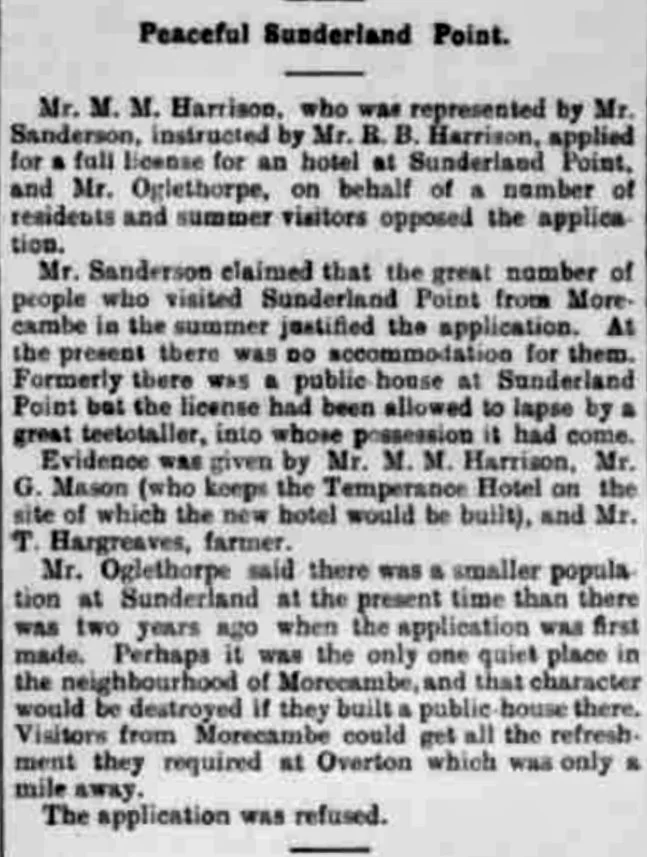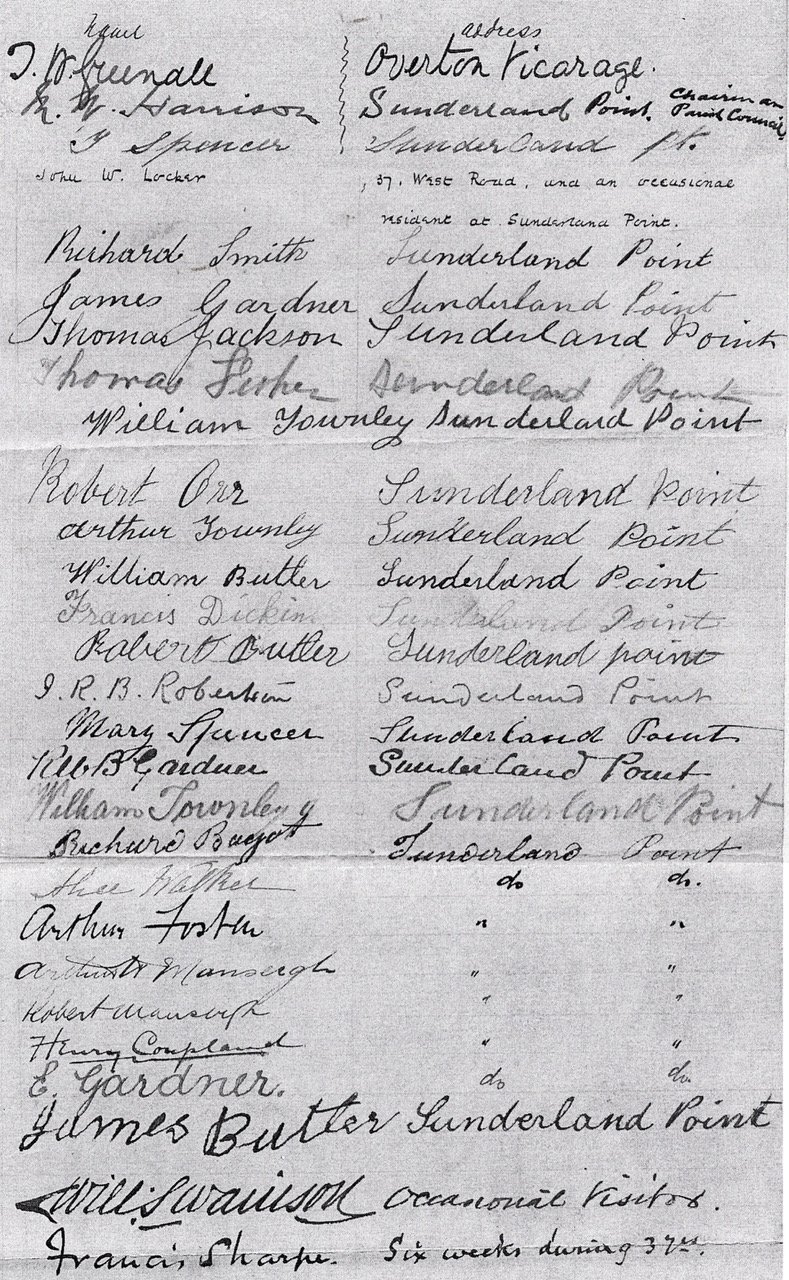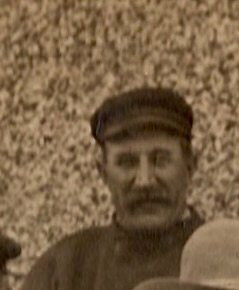New Hotel for Sunderland Point
Village in uproar
First Terrace c1905, A John Walker photograph: Courtesy Lancaster City Museums
Shock and probably the angry slamming of doors may have taken place following the announcement of a ‘New Hotel’ at the Point. Not so much against a hotel but the application for a licence to sell alcoholic beverages.
What a commotion this caused in the summer of 1898 when Michael M. Harrison submitted his proposal to the Magistrates in Lancaster to replace the Temperance Hotel with a new hotel. It’s not that long ago, not too hard to imagine.
Older residents will have recounted shocking tales of ‘rowdy drunken behaviour’ during summer weekends in earler days when thirsty visitors arrived to be entertained at the two public houses.
As they had done in 1878, incensed villagers decided to prepare a ‘memorial’ (petition) to oppose the application. Full of indignation they set about writing and collecting signatures. Their view is made with particular clarity -
Your memorialist's think such an establishment and a drinking licence is not desired by the inhabitants and is not required at all.
And the village would be -
Injured by the place being made a rendezvous for Sunday drinking by those who would come in wagonettes and by the crowds who would come in boats from Lancaster as bona fide travellers.
They thunder -
The navigation of the river is dangerous to persons in liquor and the quiet of the village would be destroyed and that a licensed house would be detrimental to the morals and peace of the place and to the interests of owners of property.
Let’s pause and turn the clock back, get a bit of background.
The End of Licensed Houses
The petition states that ‘the village has for more than 30 years had no licensed house’. This is strictly true, for in 1860 (or 1861) the Ship Inn (number 11) and the Maxwell Arms (number 14) were refused a renewal of their alcohol licence due, it is said, to visitor behaviour.
This also reflected the growing and highly vocal temperance movement who were applying considerable pressure to prevent, even revoke alcohol licences in the local area. In his memoir, James W. Gardner points a finger of blame at John Burkett Mansergh, the owner of land and buildings including the Ship Inn, who as a justice of the peace voted against the new licences.
Possibly under the direction of John Mansergh the Ship Inn changed its name to the Temperance Hotel, as seen in this advert of June 1862
Courtesy Lancaster Guardian Newspapers
Tom Wilson, the landlord, drowned in tragic circumstances in October the following year, 1863. His wife Margaret ‘Maggie’ Wilson, a woman of strong and formidable character continued at the hotel. However, in 1886 she took advantage of the availability of the Old Hall for letting - and opened her own hotel. Somewhat unofficially.
Found by Beth Hampson: Courtesy Lancaster Guardian Newspapers.
There is no record of consent being given for the sale of alcohol and would have been vigorously opposed by powerful voices. Apart from the advert, its existence only appears in the writing of James W Gardner who described it as a ‘Jerry House’ (badly run). He goes on to say.
‘She went to the Old Hall and from there she sold beer at the weekends to men who came down by boat from Lancaster, Bill Townley and Shirley Gardner as boys used to have to sit at the fish house (the simple building between houses 20 and 21) and keep watch for the police’.
The Old Hall c1900 a John Walker photo: Courtesy Lancaster City Museums.
The adventure can’t have survived for very long, three years later Maggie Wilson, with her son as landlord, were in Barrow running the Crow’s Nest Inn.
The Application of William Hodgson
In 1878, a highly contested application was made to re-license what had been the Maxwell Arms then known as Point Farm by William Hodgson, a farmer recently arrived in the village. He was represented by a Mr Whelon at the County Petty Sessions. (Edited extracts from newspaper reports).
Mr Whelon’s arguments in support.
Excursionists from Heysham and Morecambe complained that on arriving at Sunderland they could get no refreshments. The house was licenced some 14 or 15 years ago and consequently it was well adapted for the purpose of a public house. The licence was not taken away for any offence against the licensee but was merely discontinued by the then owner.
He read a memorial signed by fishermen pilots and farmers living nearby in favour of the licence being granted.
Another ground for granting the licence was no place was available where anything public could be held and recently two inquests could not be held, the jury men having to go all the way to Overton to a licensed house. (!)
Those opposing the licence were represented by the very capable and blunt Mr Tilly.
Mr Tilly submitted the applicant had not made out a shadow of a case in support of the application. There were only about 28 adults who lived at Sunderland all the year round and the applicant had only succeeded in getting 8 to sign his memorial, consequently as setting forth the wishes of the place it was worth nothing at all.
Mr Carr, the present owner bought it two or three years ago…at a cheaper rate owing to the licence having (been) lost and it was not fair to the late owner that Mr Carr should get the licence back and considerably enhance the value of his property.
It was quite evident the other persons did not want it and it would be a most perilous thing to grant a licence to a house where there was no police supervision and which was cut off from the rest of the world, so to speak for many hours out of each 24.
If the licence were granted, they would have boats going from Lancaster and men making a regular saturnalia on a Sunday (our bold type). If they wanted to put a stop to that they would have to have policemen stationed there regularly at a great additional expense.
Mr Tilly, then read a memorial against the application and said there was a good temperance hotel with accommodation for seven or eight horses and every convenience for visitors having dinners, teas, and refreshments. The memorial was signed by the Town Clerk of Lancaster and other property owners at Sunderland.
Unsurprisingly, the application was refused.
Point Farm (number 14 before the familiar porch and bay window) in the centre with Multum, the small house next door (left) c1900. A John Walker Photo courtesy Lancaster City Museums.
Back to the ‘New Hotel’ in1898
The applicant, Michael Mattinson Harrison, then aged 56 and living in Bolton-le-Sands, was one half of Harrison and Hall well known Lancaster architects and land agents, perhaps best known for their work on the Haverbreaks Estate.
Harrison had bought a significant portion of the land around the Lane owned by the Mansergh family at the auction sale in 1873, including the Ship Inn. It was he who donated the land for the Mission Church.
With hindsight it seems very strange that he went ahead. He must have known what happened to William Hodgson’s application twenty years earlier. He could not have misjudged the views of the strict abstentionists William Swainson and Robert Mansergh (both property owners who signed the petition and well known to Harrison).
After some delay it appeared at the Brewster Sessions (alcohol licensing) in August 1900. As reported in the Morecambe Visitor it received short-shrift and was turned down.
Courtesy Lancaster Guardian Newspapers
From the report we see George Mason and Thomas Hargreaves (of Sunderland Brows farm) were supporters. With just 15 acres of land to farm and the Temperance Hotel it must have been difficult for Mason to generate a living. Perhaps it was the plan to refurbish the Temperance Hotel into something more modern (the writer shudders in horror) with the fields incorporated into the Brows Farm.
Mason’s Temperance Hotel c1900 as it was at the time of the application. Courtesy Lancaster City Museums.
But what was George Mason thinking? With a wife and two young children in a small, tight community where folks rarely hesitate to speak their mind. He had been at the Hotel for at least five years, he must have known the history and the backlash he would face.
George Mason centre c1894: from the collection of Wilton Atkinson
Unlike William Hodgson who left the village shortly after his application, George survived and would be the tenant of the Temperance Hotel until his death in 1952. He must have been forgiven but perhaps carried the scars of daggers in his back.
Who were the signatories to the ‘Memorial’?
To the Magistrates at Lancaster - Your memorialists pray your worships not to grant any licence for the sale of any intoxicating liquor here.
The twenty-eight who signed were a mixture of local residents, summer visitors, landowners, and the vicar of Overton. Here they are -
Signatures to the Memorial: Courtesy Lancashire Archives
And photographs of a selection of those who signed.
For regular readers many of the names will now be familiar.
There are three ordained ministers of the church (Greenall, Robertson, and Locker) and many fishermen (Bagot, Butlers, Gardners and Townleys). William Swainson and father and son Robert and Arthur Mansergh supporters of total abstinence also signed, as did the serial adulterer Henry Coupland (for his story click here).
The names also include Wellington Harrison, owner of number 5 from 1897 to 1935 and for a time chairman of the Parish Council. He famously went swimming wearing a tunic and policeman’s helmet.
Richard Smith was the coachman to the Manserghs and lived in 3A.
We see the Butlers, James and his sons Robert and William (Billy). fishermen who lived in Cotton Tree Cottage (number 20). Francis Dickinson, another signee, was the stepson of James Butler living next door in number 19.
(James W Gardner writes mysteriously ‘the Butlers were turned out of Sunderland Point’ If true, it would have been in 1899 when they moved to Glasson Dock.)
E Gardner is unclear. It could be Elizabeth, eldest daughter of RWB and Ann Gardner (number 9). She would have been only 20 - a big surprise for an unmarried young woman to have signed. The two other women who signed were Alice Walker (number 7) and Mary Spencer (number 10) but they were both much older and widows. The other possibility was Elizabeth’s aunt also E (Edith) Gardner, but she lived in Morecambe. We vote for Elizabeth.
The last name on the list caused head scratching, after a reference to Francis Sharpe as one of the directors of the Lancaster Railway and Carriage Company in 1893, it became clearer.
Francis was a well-known local businessman, he lived in Caton the owner of an iron foundry and engineering works. His father was Edmund Sharpe – an architect in partnership with Edward Paley and later Alfred Austin who were perhaps the leading ecclesiastical architects in Northwest England.
It was Austin and Paley (Edmund Sharpe had died in 1877) who designed the Mission Church at Sunderland Point in 1894. William Swainson being one of the Trustees. It’s very likely Sharp and Swainson were well known to each other.
*
In 1909 Michael Harrison sold his land and properties to George Gilchrist (the younger). The Temperance Hotel disappeared with George’s death in 1952 but the farm limped on until 1965. In our last two photos we see George in the 1930’s and the property as it is today, not much changed.
To this day the electricity bill is still addressed to Temperance Farm.
George Mason on the steps and William Townley c 1935: Courtesy Lancashire Archives
Temperance Hotel - number 11 today
Special thanks to Kris Needham who tracked down Francis Sharpe and others, and to Beth Hampson for newspaper cuttings and hints. Thanks also to Paul Hatton for help with the list of signatures and gallery. Credit for the gallery of photos, the collections of Wilton Atkinson, Hugh Cunliffe and Alan Smith, the Gardner family, and the Gilchrist family.

























